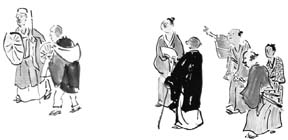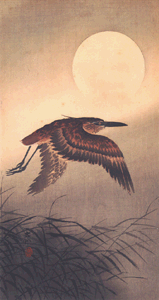The Essential Basho, translated by Sam Hamill, Boston: Shambhala, 1998. Reviewed by George Hartley |
xx |
 |
The Essential Basho, translated by Sam Hamill, Boston: Shambhala, 1998. Reviewed by George Hartley |
xx |
 |
Just before his death in November 1694, Matsuo Basho wrote the following haiku:
| All along this road
not a single soul—only autumn evening |
xxxx | Kono michi ya yuku hito nashi ni aki no kure |
This "road," Sam Hamill tells us in his moving afterword to his important new translation of Basho's travelogues, is at once the road of poetry, the road of Zen practice, and the road of life itself. All of these are one for Basho. So it was through his lifelong development of the Way of Poetry. In the autumn of his life Basho concerned himself with this road without a single soul; not only do we travel this road alone, but even the status of our own self ultimately has no meaning when confronted with the lonely depths of an autumn evening.
The Basho we get in Hamill's translation is the Zen poet pilgrim. As in Peter Matthiessen's The Snow Leopard, Basho's works illustrate the unity of the journey and Zen practice.
 |
x | Hamill's collection emphasizes this insight by centering on Basho's travelogues: the infamous Narrow Road to the Interior, a long meditation on the ecstasy and the sorrow of each moment of awareness; Travelogue of Weather-Beaten Bones, a record of Basho's pilgrimage on the path of his spiritual and poetic master, Saigyo; The Knapsack Notebook, an exploration of the fusion of pilgrimage and poetry; and the Sarashina Travelogue, an account of his trip to see the harvest moon rise over Mount Obasute. The travelogues are then followed by an 82-page selection of Basho's haiku. |
This structure of Hamill's collection provides for an instructive way of viewing Basho's haiku. In the travelogues the haiku are interwoven with narrative passages that place each haiku in the context of its inspirational circumstances. For example, in the selcetion of haiku we read:
| Spring passes
and the birds cry out—tears in the eyes of fishes |
As a single poem these lines are beautifully haunting and evocative, moreso because of their ambiguity. Why are the birds crying out? Are these cries of joy or of sorrow? Are they celbrating or lamenting the passing of spring? Is spring even directly related to this crying, or is it simply functioning as contextual background? In either case, the idea of fishes' tears being distingushable from the water in which they swim is at once amusing and mysterious, engaging that mental twist of koan paradox. But consider this haiku in its prosaic context:
|
 |
|||||||||
Now we see the haiku as a response to Basho's sorrow at leaving his friends for his pilgrimage. The crying of birds and fish presents a sympathetic fusion of Basho and his world—his sorrow is so great that tears form even in the eyes of fish. This fusion, occuring on many levels, is perhaps the most striking element of Basho's travelogues.
 |
xx | Haibun is the term for this fusion at the formal level, the level at which haiku and prose are combined. This provides for a formal dialogue between the poem and the narrative in which each inflects and thereby enriches the other. This is one level at which Hamill's collection especially excels, both in the insight we get into Basho's aesthetics through his works and through the explanatory passages of Hamill's own introduction and afterword. Here Hamill explains, for example, that two fundamental principles underlie Basho's poetics, kokoru (the heart/mind aspect of the poem) and makoto (sincerity, directness). The direct sincerity of Basho's writings, seen in his spare yet elegant style, functions as an attempt to go right to the heart of things, to see the relationship between core and surface. But this core of reality is not some distant, abstract essence; it is insight into things as they are (a point also strongly emphasized by Robert Aitken in his book on Basho's haiku, A Zen Wave). This insight is summed up by the phrase mono-no-aware, the perception of the natural poignancy of temporal things. Like the dropping cherry blossoms, we too will wither and die. This insight, crucial to Zen, leads us beyond simple attachment to temporal things, demanding the full experience of the present moment, here and now.
|
The title of Basho's most famous travelogue, Narrow Road to the Interior, plays on his concern for the heart of things. On one level the "interior" refers to the wilderness region called Oku north of Sendai. The narrow road passes through the Shirakawa Barrier, over the mountains. Yet the title also refers to the path of Zen as a practice of experiencing the void of the self at the heart of all experience. Like Zen and the Art of Motorcycle Maintenance, Basho's book reveals that the journey itself is the destination. "A lifetime adrift in a boat," Basho writes, "or in old age leading a tired horse into the years, every day is a journey, and the journey itself is home" (3).
If Hamill's translations have a weakness, it is in fact their rare failure to convey this immediate attention to the here and now. While Hamill's translations tend to be more aesthetically pleasing than Aitken's, they nevertheless at times overlook a recurrent syntactical move of Basho's: the isolation and emphasis of a phrase by the emphatic element ya. Ya functions as the exclamation point does in English, and consequently the phrase preceding it should stand in stark immediacy. Hamill translates the first line of the haiku with which I open this review as "All along this road" (Kono michi ya). But Aitken, emphasizing the ya, writes, "This road!" The road (tao in Chinese, michi in Japanese) is central to the experience, not simply background or setting for the experience of emptiness or loneliness. This road is not just a figurative vehicle for expressing the road of poetry or Zen or life; this road, the actual physical road leading into the interior, is poetry, Zen, life. There is no distinction between literal and figurative experience. Hamill's awareness of this key element of Basho's poetics, despite any momentary lapses in translation, is what makes this collection and translation especially poignant and moving. Hamill's strength is exactly this fidelity to the beauty of Basho's work, a beauty which, Hamill tells us, lies in the poet's adherence to the belief that "each poem is the only poem."